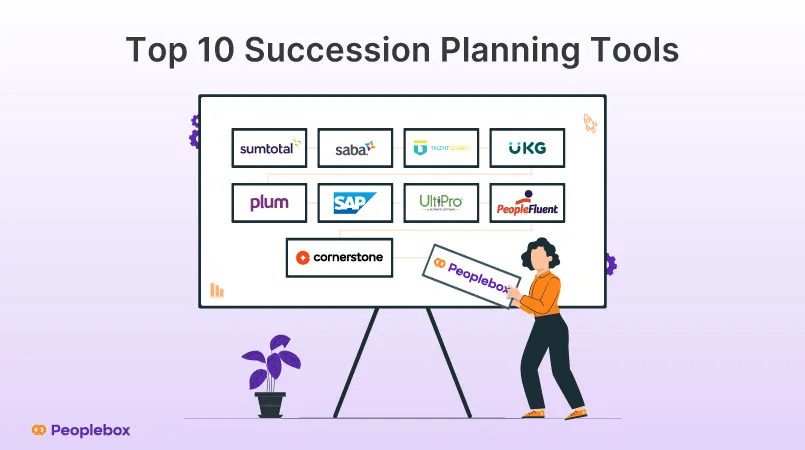If you are wondering why you need a succession planning tool? Here are some stats for you.
According to McKinsey, an astonishing 83% of global leaders feel inadequately prepared for their impending duties. But surprisingly, only 35% of organizations have established a structured succession planning procedure for pivotal positions.
The result? Unprepared leaders lead to business failure.
Another study conducted by the Corporate Executive Board (CEB) found that 50% to 70% of executives fail within 18 months of taking on a role, whether external hires or internal promotions. Which means they were not prepared to take up the job they have been hired to do.
The staggering statistics speak for themselves: a leadership vacuum can be catastrophic for an organization. Not only does it disrupt operations, but it can also erode shareholder confidence, alienate customers, and demoralize employees.
This is where succession planning comes into play. By proactively identifying and developing high-potential talent, organizations can mitigate risks, ensure business continuity, and achieve long-term success. In this article, we will explore the top 10 succession planning tools that can empower you to build a robust leadership pipeline.
The top succession planning software we will cover are:
- Peoplebox
- UKG pro
- SAP
- Succession Wizard
- PeopleFluent
- Plum
- Saba
- SumTotal
- TalentGuard
- UltiPro
❓What Is A Succession Planning Tool?
A succession planning tool helps organizations create a strategic succession plan that identifies and nurtures individuals to step into key leadership roles. These tools safeguard business continuity and fuel growth by ensuring a smooth leadership transition at all levels.
This strategic endeavor acknowledges the inevitability of change and prepares organizations to adapt to market fluctuations, embrace technological advancements, or respond to unforeseen crises.
🏆 Top 10 Succession Planning Tools
| Tool | Pros | Cons |
| Peoplebox | Intuitive and simple designStreamlines performance managementAdaptable to organizations of all sizesIn-depth people insights | NA |
| UKG Pro | Supports payroll, income tax management, onboarding, etc.User-friendly interface | Steep learning curveComplex onboarding process |
| SAP | Streamlines talent management and payroll Deeper insights into employee behaviorRobust features to monitor and track employee progress | May encourage employees to focus on limited goalsUI could be betterComplex integration process |
| Succession Wizard | User-friendly UIMonitor employee career advancement | Limited features Limited customization options |
| PeopleFluent | Tracks staff and potential successorsSupports setting and monitoring goalsBased on the internal talent assessment approach | Slightly difficult to understandRequires a lot of time to learn |
| Plum | ScalabilityUser-friendly interface | Lacks regional data filtersComplex report generation |
| Saba | Simplifies training processOffers personalized learningCustomization options | Unresponsive customer supportHigh learning curve |
| SumTotal | Development and career growth tracking features are easy to useOffers a variety of courses for employees and managers | Complex customization featuresDifficulty in navigating screens |
| TalentGuard | Create transparent career progression plansEmployee-drive software. It helps create multiple career paths | Slow load timeBasic reporting features |
| UltiPro | Offers custom reporting featuresUser-friendly tool | The UI requires updatingCustomer support does not address issues on time |
1. Peoplebox

Peoplebox is a strategic performance management platform that plays a vital role in succession planning for organizations. By focusing on identifying and nurturing high-potential employees, Peoplebox helps ensure that organizations are prepared for future leadership transitions. This tool provides a structured approach to succession planning, allowing companies to build a strong talent pipeline aligned with their strategic goals.
✔️ Key Features
- 9-Box Grid: This visual matrix is a highlight of Peoplebox’s succession planning capabilities. By categorizing employees based on their performance and potential, the 9-Box Grid helps organizations quickly identify high-potential individuals who are ready for leadership roles.
- Talent Pools: Peoplebox allows HR professionals to create custom talent pools based on specific criteria such as skills, experience, and career aspirations. This makes it easier to identify potential successors for key positions and track their progress.
- Development Plans: The platform enables organizations to create personalized development plans for high-potential employees. These plans outline specific goals, training programs, and mentorship opportunities to help individuals acquire the skills and knowledge needed to succeed in leadership roles.
- Performance Tracking: Peoplebox’s performance management software provides real-time data on employee performance. This information can be used to identify top performers, assess their readiness for advancement, and identify any skill gaps that need to be addressed.
- Data Analytics: Peoplebox offers a suite of analytics tools that provide valuable insights into an organization’s talent pipeline. These analytics can help HR professionals identify potential bottlenecks, assess the effectiveness of development programs, and make data-driven decisions about succession planning.
- Competency Management: The platform supports competency assessments, allowing organizations to evaluate employee skills and align them with organizational needs for effective talent management. Peoplebox’s competency management feature helps identify critical skills required for current and future business objectives, ensuring that talent strategies are aligned with strategic goals.
- Skill Mapping: Peoplebox enables organizations to map employee skills against required competencies, identifying gaps and guiding targeted development efforts. By creating a visual representation of skill proficiency across the workforce, Peoplebox helps bridge talent gaps, optimize training programs, and improve talent mobility.
👉 Pros of Peoplebox
- Peoplebox seamlessly integrates with 100+ tools, enhancing workflow and data management across platforms.
- The platform utilizes AI to provide insights and recommendations, improving decision-making and performance tracking.
- Peoplebox offers extensive customization options, allowing organizations to tailor HR processes to their specific requirements.
- The user-friendly interface makes it easy for teams to navigate and utilize the platform effectively.
- Peoplebox serves as a comprehensive solution for managing talent, helping organizations identify, engage, and retain their best employees.
💰 Pricing
Peoplebox offers a free trial, with paid plans starting at $7.00 per month per user, making it an affordable solution for organizations of all sizes.
2. UKG Pro Succession Planning Tool

The UKG Pro is a Strategic succession planning tool designed to address seamless leadership transition. By facilitating the identification, development, and readiness of potential successors, this tool helps create valuable people assets for organizational stability. It offers robust features, a user-friendly interface, and aims to empower organizations to ensure a smooth and effective transition of leadership roles.
✔️ Key Features
- Personalized development plans: The UKG Pro platform enables employees to develop their distinct talents that significantly contribute to the organization’s success through personalized development plans. Within the tool, individuals can acquire the necessary skills and competencies, nurturing their career growth and personal fulfillment.
- Identify Emerging Leaders: The UKG Pro Succession feature provides a comprehensive understanding of both current talent and future potential within the organization. This tool facilitates effortless discovery, tracking, and comparison of individuals, pinpointing and evaluating potential successors tailored for specific roles.
- Comprehensive Talent Insights: It has robust people analytics and reporting capabilities that empower well-informed decisions concerning talent mobility across the organization. This functionality offers a holistic view of the workforce, all conveniently accessible within a unified platform.
👉 Pros of UKG Pro
- UKG Pro offers a wide array of functions, including file storage, payroll processing, income tax management, onboarding, and compliance training.
- The successful integration of UKG with other systems for payroll processing is an added advantage.
- It has a user-friendly interface that caters to both employees and administrators, enhancing accessibility and usability.
👉 Cons of UKG Pro
- UKG has a learning curve that can be challenging to navigate. Users feel a distinction between Dimensions and PRO features, even after integration, which requires additional time for them to become proficient.
- The onboarding process, while comprehensive, presents a drawback in terms of complexity. The requirement for multiple websites and logins for various components of the process can create confusion and administrative burden.
💰 Pricing
Undisclosed
3. SAP SuccessFactors Succession & Development
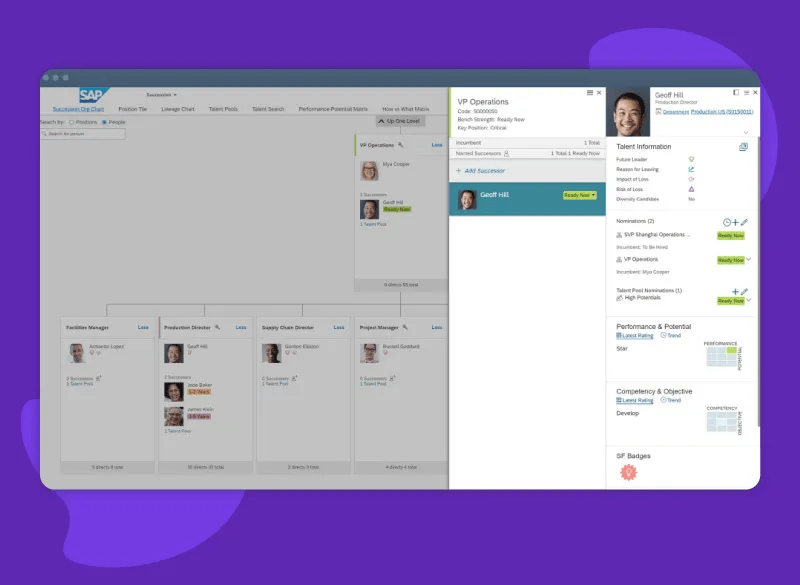
The SAP SuccessFactors Succession & Development Tool helps organizations enhance the efficiency of their succession planning endeavors. It offers valuable visibility and planning capabilities, enabling strategic support for future growth initiatives, identification, cultivation, and readiness of potential successors.
✔ Key Features
- Talent Identification: The tool enables the identification of high-potential individuals, spotlighting those who possess the necessary skills, competencies, and qualities required for effective leadership roles. The robust analytics and reporting functionalities provide actionable insights, enabling data-driven decision-making for succession planning and talent development.
- Talent Pools: Through intuitive interfaces, the tool facilitates the creation and management of succession pools, ensuring a well-prepared lineup of potential successors for critical roles.
- Development Plans: SAP offers tailored development plans for individuals, mentorship, addressing skill gaps and aligning growth paths with leadership requirements.
👉 Pros of SAP
- The integration of payroll and talent management features offers a holistic view of employee management, streamlining processes and enhancing overall efficiency.
- SAP SuccessFactors, the tool provides deeper insights into employees’ organizational behavior, enabling better decision-making and strategic planning.
- It offers robust capabilities to easily monitor and track progress, the tool enhances transparency and facilitates effective performance management processes.
👉 Cons of SAP
- According to G2 reviews, one potential downside of this tool is that it might inadvertently encourage individuals to concentrate solely on particular goals.
- There is room for improvement in UI, as it could be more intuitive and user-friendly.
- The integration process and ongoing maintenance of SAP SuccessFactors with other systems can pose challenges in terms of time and resources.
💰 Pricing
Available on request
4. Succession Wizard

Succession Wizard enables organizations with streamlining the succession planning process. It recognizes potential gaps in succession and aids in strategizing future staffing requirements. By assisting in identifying and grooming potential successors, this tool becomes a strategic asset in maintaining an effective leadership pipeline.
✔ Key Features
- Customized Development Plans: Organizations can create tailored development plans for potential successors, addressing specific skill gaps and aligning growth with leadership requirements.
- Talent Identification: The tool aids in identifying high-potential individuals within the organization who possess the skills and competencies necessary for future leadership roles.
- Succession Pools: The tool facilitates the creation and management of succession pools, ensuring a prepared pool of potential successors for critical positions.
👉 Pros of Succession Wizard
- Succession Wizard offers user-friendly UI, coupled with features that intuitively guide users through various succession planning tasks.
- It offers a seamless experience and facilitates tasks such as evaluating employee performance, pinpointing skill deficiencies, and monitoring career advancement, along with other essential metrics.
👉 Cons of Succession Wizard
- Succession Wizard’s focus on succession planning excludes other comprehensive HR functions, potentially requiring integration with broader HR systems.
- Certain users seek greater flexibility in tailoring the software to align with their organization’s unique succession planning needs.
💰 Pricing
Starting at $399 per month
5. PeopleFluent
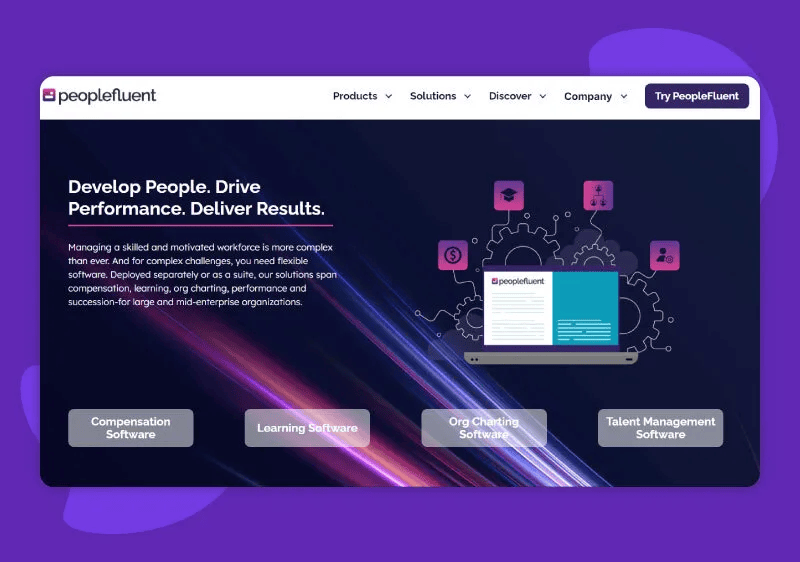
PeopleFluent is one of the top succession planning tools designed to identify, nurture, and propel future leaders. From talent identification to personalized growth pathways, PeopleFluent empowers organizations to harness data-driven insights and make informed decisions, ensuring a prosperous future by cultivating the leaders of tomorrow.
✔ Key Features
- Talent Pipeline: PeopleFluent Succession Planning software enables you to identify hidden gems and cultivate them into guiding lights. It allows you to scout for emerging leaders and also nurtures their growth from within, fostering a comprehensive talent pipeline.
- Balancing Data and Soft Skills: The tool helps in accessing leadership potential by incorporating both quantifiable outcomes and intangible soft skills, providing a comprehensive understanding of your future leaders.
- Identify Gaps and Adapt: PeopleFluent’s robust functionality empowers you to delve into your organizational landscape, identify gaps in leadership readiness, and tailor succession plans to align with your talent pool and strategic objectives.
👉 Pros of PeopleFluent
- PeopleFluent Succession Planning system effectively facilitates the tracking of staff and potential successors, providing a structured approach to mapping out career trajectories. It serves as a comprehensive solution for HR planning and operations.
- Staff members can set and monitor goals, fostering a culture of engagement and accountability during manager 1:1s.
- PeopleFluent Succession Planning embraces an internal talent assessment approach, recognizing and nurturing the existing talent pool to fill various roles based on merit.
👉 Cons of PeopleFluent
- It is equipped with the necessary tools for planning and mapping out strategies. However, due to its specialized and standalone nature, users find it slightly more challenging to grasp compared to the familiar tools.
- It demands a significant time investment.
💰 Pricing
Undisclosed
6. Plum
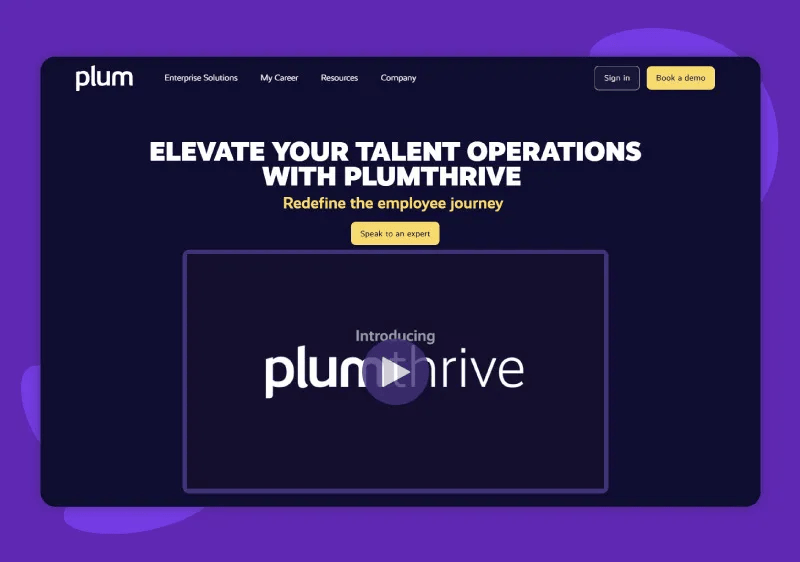
Plum is a robust tool that helps organizations with employee engagement, development, creating a robust talent pool and retention, leveraging the intuitive personal insights.
✔ Key Features
- Empower Employee Potential: Empowering employees, Plum provides access to a myriad of resources catering to their passions and easing the burdens. Via a self-guided resource repository, Plum fosters career growth, allowing employees to thrive.
- Talent Flow: Plum seamlessly pinpoints top contenders across departments and fill positions internally. It helps you stay aligned with shifting job requirements, sourcing talent within to seamlessly cater to business demands.
- Preparing Tomorrow’s Workforce: Plum facilitates the recognition of leadership potential in employees primed for pivotal roles. By removing biases from succession planning and harnessing Plum’s Talent data, effortlessly strategize for organizational chart adjustments.
👉 Pros of Plum
- It offers great scalability.
- It has an attractive interface which enhances the experience, and categorizing Top Talents, Work Style, and Work Preferences strategically boosts tool usage.
👉 Cons of Plum
- While comprehensive, it lacks regional data filters, crucial for localized branches or small offices requiring employees from the same region.
- Generating candidate result reports isn’t straightforward and takes considerable effort.
💰 Pricing
Undisclosed
7. Saba (Cornerstone)
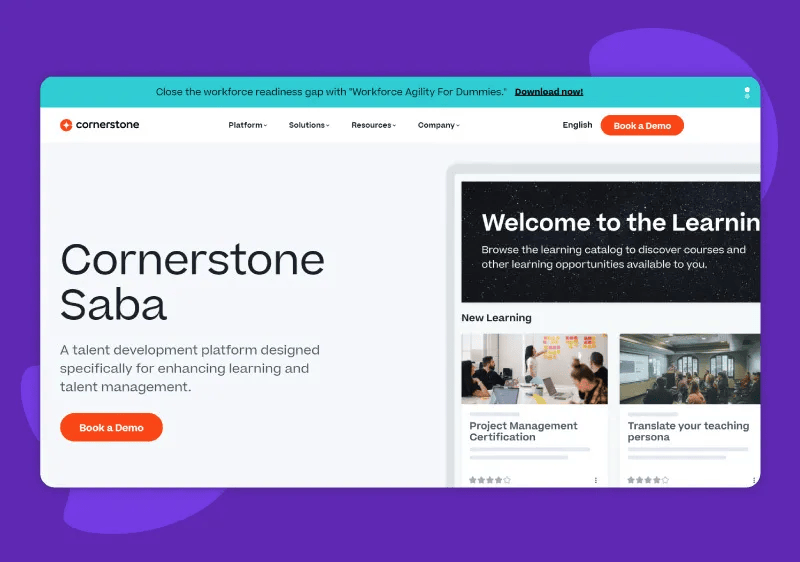
Saba is a comprehensive talent management tool with succession planning features. It seamlessly integrates cloud-based solutions, expert services, and a thriving community. From performance management to learning and development, succession and leadership, compensation, and recruiting, Saba TalentSpace™ offers a unified solution.
✔ Key Features
- Performance Management: Saba offers a versatile performance management software, crafted to foster an environment of continuous feedback and coaching. It seamlessly aligns, engages, and empowers your workforce to accomplish the business outcomes that matter most.
- Succession and Leadership Empowerment: Saba’s succession planning tool helps you address skill gaps and cultivate robust leadership capabilities and skilled professionals across critical business domains. It helps you create competency-driven talent pools to nurture top-tier potential, ensuring an engaged, and committed workforce.
- Learning and Skill Development: Saba is a succession planning tool that offers learning and development features that equip you with the essential tools to cultivate a workforce that is not only highly skilled but also deeply engaged. This impactful learning solution seamlessly interconnects on-the-job learning, continuous coaching, and formal learning activities, directly aligning with your overarching business strategy.
👉 Pros of Saba
- Saba serves as a comprehensive virtual training center, simplifying the training process. From tracking completions to saving progress, the succession planning tool offers a unified solution for seamless training
- It offers personalized learning experience by providing you the ability to highlight crucial training modules at the top of the Learning Library and tailor automatic replies.
- Saba offers customization options that empower you to tailor the system to their unique needs. Additional features can be added based on budget allowances, ensuring a personalized solution.
👉 Cons of Saba
- The customer service for Saba appears to be lacking, potentially affected by the system’s ownership by a larger company, leading to a perceived shift in priority.
- It comes with a learning curve before you get acclimated to using the tool.
💰 Pricing
Undisclosed
8. SumTotal
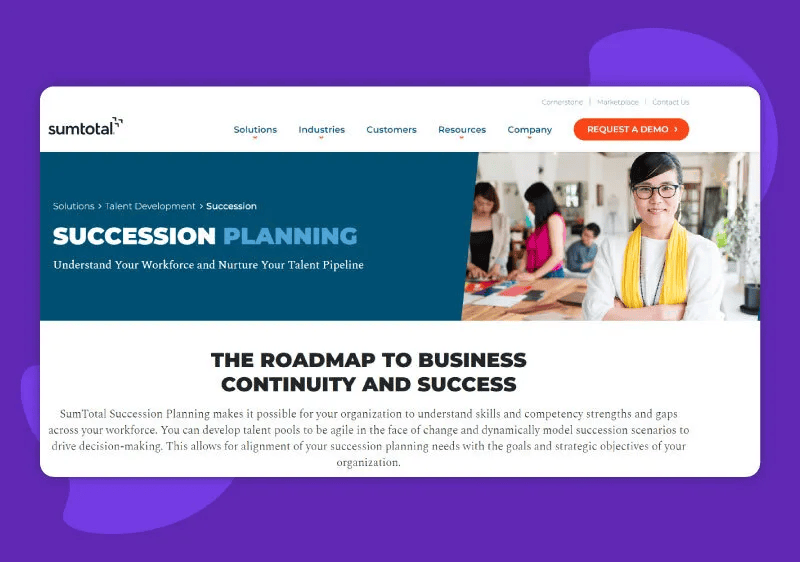
SumTotal is a succession planning tool that helps identify competency strengths and problem areas across your workforce. It enables you to build flexible talent pools and align your succession planning objectives with organizational goals and objectives.
✔ Key Features
- Develop Leaders: The succession planning tool lets you identify talent gaps and prepare employees for future positions within the organization. It helps you create personalized and targeted training plans to upskill high performers.
- Dynamic Talent Pools: SumTotal enables you to group employees based on custom-defined criteria. Thus, you can plan targeted learning and growth programs.
- N-box grid: The succession planning software’s n-box feature allows you to visualize your team’s potential and readiness. It helps identify the top talents and model succession plans accordingly.
👉 Pros of SumTotal
- SumTotal’s development and career growth tracking features are easy to use and beneficial.
- The succession planning tool offers a variety of courses for individuals to choose from and learn at their own pace.
👉 Cons of SumTotal
- The customization features in SumTotal are complex. Some features lag and are less intuitive.
- The system is not very user-friendly. Navigating the screens is difficult, and sometimes, downloading courses requires assistance.
💰 Pricing
Undisclosed
9. TalentGuard
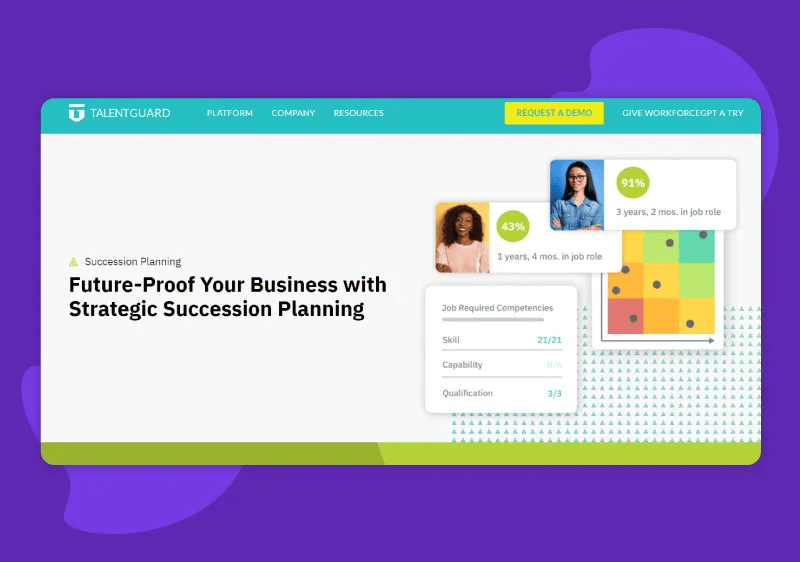
TalentGuard is an AI-powered platform that helps HR teams manage succession planning, people development, performance, and training programs. The succession planning tool provides a comprehensive view of the organization’s collective potential and skills, helping you identify and nurture the top talents.
✔ Key Features
- Talent Finder: The succession planning tool offers advanced talent search features to locate the right talent within the organization. It also identifies succession gaps to ensure that managers know where successors need additional development.
- Risk Mitigation Center: This feature allows you to centralize succession gaps and potential risks in the succession plan to address inconsistencies proactively. It reduces bias in the candidate selection process using verified employee skill data.
- Talent Plan: The succession planning tool helps you manage talent planning sessions. It provides key insights into employee talent data for performance-based selection and accurate matching features to find candidates based on skills and competencies.
👉 Pros of TalentGuard
- The tool helps create transparent career progression plans. The employees can view what they’re required to do (from a skills POV) to execute their role and what skills they will need to acquire to grow in their desired role.
- The software is employee-driven. It helps them build multiple career paths and view the gaps they must fill to reach their goals.
👉 Cons of TalentGuard
- The succession planning tool’s user interface could be improved. It feels outdated, and the load time can be slow.
- The reporting features are basic. It limits in-depth data analysis for workforce planning.
💰 Pricing
- Free trial: $0
- Automate: $1250 per month/ 5 seats
- Engage: $7 per user/month
- Optimize: $12 per user/month
10. UltiPro
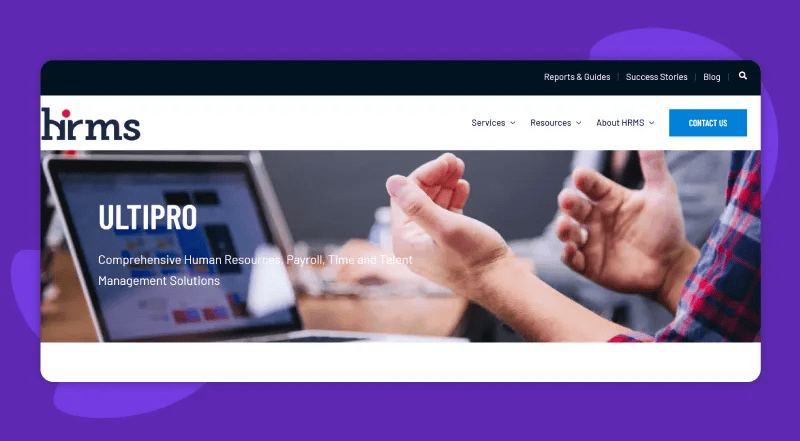
UltiPro by UKG is a unified HR, payroll, and talent management solution that offers succession planning and management features to identify potential leaders within your organization. It simplifies employee performance and progress, allowing you to set goals and develop succession plans based on employee potential.
✔ Key Features
- Learning Experience: UltiPro offers access to consumable resources, such as social and collaborative tools and on-demand content. It uses a person-centric approach to provide employees with a modern learning experience.
- Performance Management: With UltiPro, you can access user-friendly tools that provide critical insights into employee data and performance metrics. Thus, you can make more targeted plans, set talent objectives, and make informed strategic decisions.
- Succession Management: The succession planning software helps you create detailed, flexible, and realistic succession plans to prepare employees for key positions at all levels.
👉 Pros of UltiPro
- UltiPro is user-friendly, and it offers adequate resources for assistance.
- The succession planning tool offers custom reporting features that help analyze different metrics.
👉 Cons of UltiPro
- According to several users, UltiPro’s UI is not very intuitive. It requires updating.
- UltiPro’s custom support does not address issues on time. Though their Rapid Response hotline is helpful, it requires much pushing from the customer’s end to mark a case as ‘priority.’
💰 Pricing
Undisclosed
🤔 Why Should You Choose A Succession Planning Platform?
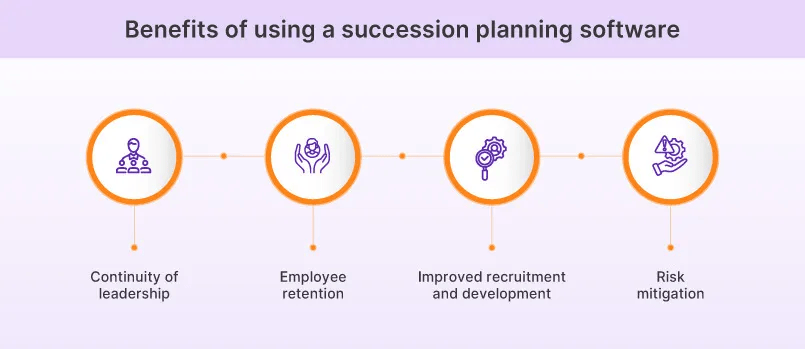
Succession planning gives your business a competitive edge and succession planning solutions offer several benefits to ensure seamless succession planning and execution. Here are a few:
1. Continuity of leadership
Succession planning tools help identify and nurture potential future leaders within an organization. This ensures hassle-free transitions when key positions demand new employees, reducing disruptions in workflow.
2. Employee retention
Succession planning tools set clear career paths and provide development opportunities based on individual potential. This increases employee engagement and retention as they are likely to stay with companies that offer good career growth.
3. Improved recruitment and development
Succession planning tools identify skill gaps in the workforce and help companies plan targeted recruitment and training programs. They help implement a more effective and strategic hiring and decision-making process within the organization.
4. Risk mitigation
Succession planning tools prepare organizations for unexpected retirements or departures of people holding critical positions. They help build a pool of qualified employees who are ready to step into key roles, reducing the risks related to sudden leadership gaps.
⚙️ What Are The Key Features To Look For In A Succession Planning Solution?
While you must choose succession planning tools based on your specific needs, here’s a list of features to look for when choosing your tool:
- Talent and skill gap assessment capabilities: Choose a succession planning tool with integrated talent assessment functions to evaluate employee skills, competencies, potential, and talent gaps.
- Talent pools and pipelines: Get a succession planning solution that helps you create a pool of candidates who can take up future roles and identify the high-performers who can be prepared for specific roles within the organization.
- Performance tracking: Make sure that your succession planning software solution has advanced performance monitoring capabilities so you can track employee progress and plan your training and development programs accordingly.
- Modeling tools: The best succession planning tools integrate advanced modeling like dynamic organizational charting, what-if scenarios, etc. Organizational charting visually represents the critical roles within the company, and what-if scenarios highlight specific situations that need action.
👉 Challenges Organizations Face Without Proper Succession Strategies
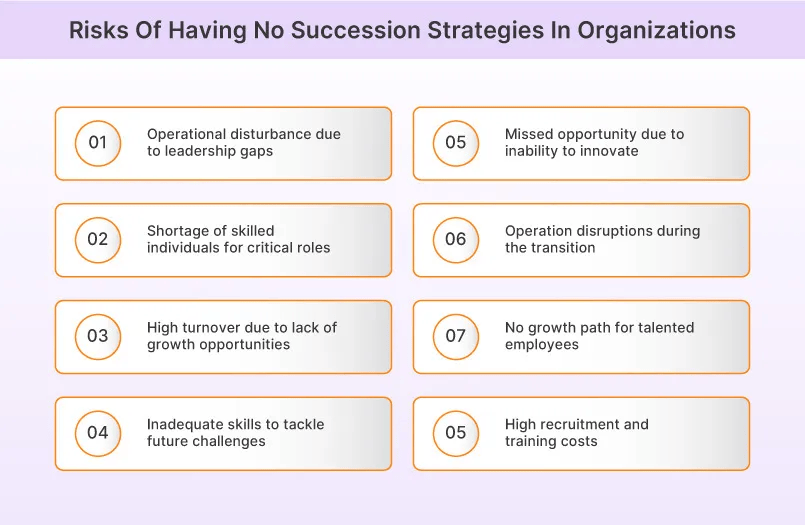
The absence of effective succession planning strategies can expose your organization to a plethora of challenges that can hinder growth and stability. Let’s take a quick look into these challenges and understand how a well-structured succession plan is essential for addressing them and how a tool helps you.
1. Sudden leadership gaps leading to operational disruptions
When a key leader departs without a designated successor, it can trigger operational chaos. The absence of a seamless transition plan might lead to confusion, disarray, and inefficiencies, ultimately impacting the organization’s performance and its ability to meet its objectives. With a clear overview of high-potential employees, succession planning tools facilitate the identification and development of potential leaders across the organization
Guess what? Peoplebox offers a 9-Grid Box Feature to identify high-performers easily. Explore the demo to know more.
2. Shortage of qualified candidates for critical roles
Without a strategic approach to grooming future leaders, organizations may find themselves grappling with a shortage of skilled individuals prepared to take on critical positions. This scarcity hinders growth prospects and impedes the organization’s ability to remain competitive. Succession planning tools enable organizations to identify skill gaps in advance and create targeted development plans.
3. Disengagement and turnover due to lack of growth opportunities
Employees are more likely to stay engaged and committed when they perceive growth opportunities within the organization. Without clear paths for career advancement, talented individuals may seek greener pastures, resulting in turnover and the loss of valuable expertise. By providing a clear view of advancement opportunities, succession planning enables organizations to map out career paths and growth trajectories for employees.
4. Inadequate skills to address future business challenges
Organizations without a robust succession plan might find themselves ill-equipped to navigate changing market dynamics and emerging industry trends. With predictive analytics, succession planning tools help anticipate future skill requirements based on industry trends and organizational goals.
5. Missed opportunities due to inability to innovate and adapt
Leadership continuity is crucial for fostering innovation and adaptability. Without new leaders who can bring fresh perspectives and drive change, organizations risk missing out on opportunities to innovate and capitalize on emerging trends. Succession planning tools enable organizations to groom innovative thinkers who can adapt to change and drive transformation.
6. Disruptions in operations and customer relationships during transitions
A lack of proper succession planning can disrupt not only internal operations but also customer relationships. Customers might be accustomed to a certain level of service, and sudden changes in leadership can lead to inconsistencies, affecting customer trust and loyalty. By providing guidance on responsibilities and expectations, succession planning tools mitigate disruptions, ensuring a consistent customer experience.
7. Talented employees lacking development opportunities
Talented employees are the lifeblood of any organization. Without a plan to develop their skills and nurture their potential, you risk losing these valuable assets to competitors who offer better growth prospects. Succession planning guides an employee’s growth journey, demonstrating your commitment to their growth and reducing the risk of losing them.
8. High costs associated with external recruitment and training
When succession plans are absent, organizations often resort to external recruitment, which can be costly and time-consuming. Additionally, the need to train new hires intensively can further strain resources. By identifying and nurturing potential leaders from within, these tools minimize recruitment expenses and accelerate the onboarding process.
According to a report by Training Magazine, on average, companies spent $101.8 billion on training employees in 2022- 2023.
🎯 10 Tried & Tested Succession Planning Strategies
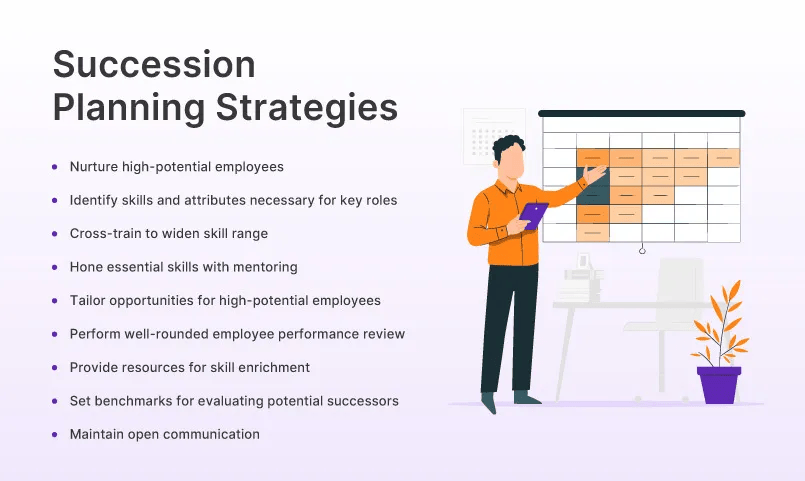
Ensuring a seamless transition of leadership is paramount for sustained growth and progress. Let’s take a look at some of the effective strategies that empower you to identify, nurture, and prepare potential successors.
1. Talent Pipeline Development
A fundamental approach in successful succession planning is the creation of a talent pipeline dedicated to nurturing high-potential employees for forthcoming leadership positions.
Identify individuals who exhibit the essential skills, competencies, and potential necessary for effective leadership. Through targeted development initiatives, these potential successors can be groomed to seamlessly assume key positions, ensuring a continuous flow of capable leaders within the organization.
2. Identifying Key Roles and Competencies
This is an integral step in the succession planning process, recognizing pivotal roles within the organization and pinpointing the specific competencies necessary for it. By comprehensively understanding the skills, knowledge, and attributes essential for success in each role, you can strategically plan and align succession planning efforts to ensure a seamless transition of leadership.
3. Cross-Training and Job Rotation
Facilitating cross-training and job rotation initiatives offers employees invaluable chances to garner expertise across various departments and roles. This practice not only widens their skill repertoire but also exposes them to diverse facets of the business.
By familiarizing themselves with different functions, employees become better equipped for future roles, armed with a comprehensive understanding of the organization’s operations.
4. Mentorship and Coaching Programs
Implement mentorship and coaching programs that pairs potential successors with seasoned mentors or coaches from the senior leadership team. This strategy facilitates the transfer of knowledge, hones essential skills, and offers invaluable guidance for career progression. Through these relationships, aspiring leaders gain insights, learn from experience, and receive personalized support that prepares them to step confidently into future leadership roles.
According to Christian McCarrick, Engineering Director at Meta & Mentoring Expert, before mentoring, understand “What do you see for this employee? Are you grooming them for management or a top individual contributor role? Once you set a goal (and the employee agrees) now you have to build a plan to get there.”
5. Individualized Development Plans
Creating individual development plans for high-potential employees is a pivotal strategy that is based on an individual’s strengths, areas for improvement, and career aspirations. By tailoring learning opportunities to target specific skill gaps and bolster leadership attributes, you can ensure that potential successors receive personalized guidance to flourish in their roles.
6. Performance Management Alignment
By integrating performance management and succession planning, you can ensure that leadership potential is a key factor in performance assessments. This alignment not only reinforces the connection between performance and leadership readiness but also ensures that the right individuals are being groomed to drive the organization’s future success.

7. 360-Degree Feedback
Employing a 360-degree feedback approach includes collecting input from peers, subordinates, and supervisors to evaluate an employee’s aptitude for leadership. This comprehensive feedback mechanism offers a well-rounded perspective on an individual’s strengths and growth areas.
Tools like Peoplebox, offer extensive features for 360-degree reviews and feedback. By collecting insights from various angles, you gain a thorough understanding of potential successors, aiding their development journey and enhancing their readiness for leadership roles.
8. Continuous Learning Culture
Nurturing an environment of continuous learning encourages employees to actively pursue growth opportunities. Provide resources, online courses, and support for skill enrichment. By fostering this culture, employees are empowered to develop their abilities and remain adaptable in an ever-evolving business landscape.
9. Defining Leadership Attributes
Clearly outlining the leadership behaviors and qualities that align with your organization’s values and objectives is essential. These criteria serve as benchmarks for evaluating potential successors and guiding their growth. By identifying the traits that resonate with your organizational ethos, you ensure that your leadership pipeline is aligned with your strategic aspirations.
10. Transparent Communication
Transparently communicating the significance of succession planning to employees across all tiers of the organization is crucial. By maintaining openness about the criteria and procedures used to select future leaders, organizations foster a sense of clarity and inclusivity.
💡Did you know Peoplebox integrates with your favorite platforms? Be it Slack, Notion, or MS Teams, connect and get everything in one place. Try now!

👉 Excel Your Organization With The Best Succession Management Software
While it is clear that mastering the art of succession planning is the key to maintaining uninterrupted growth, the path to bridging the leadership gap and ensuring a seamless transfer of responsibilities can be difficult. These tools help you navigate difficult seas with ease and offer features that do more than just improve your succession planning.
To see how well a succession planning tool can help you, you can take a personalized demo with Peoplebox. Take the next step towards securing your organization’s leadership future.
Schedule a demo today!

